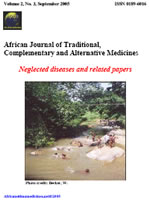
|
African Journal of Traditional, Complementary and Alternative Medicines
African Ethnomedicines Network
ISSN: 0189-6016
Vol. 8, No. 2, 2011, pp. 144-149
|
 Bioline Code: tc11020
Bioline Code: tc11020
Full paper language: English
Document type: Research Article
Document available free of charge
|
|
|
African Journal of Traditional, Complementary and Alternative Medicines, Vol. 8, No. 2, 2011, pp. 144-149
| en |
Ethnobotanical And Antimicrobial Studies Of Some Plants Used In Kibwezi (Kenya) For Management Of Lower Respiratory Tract Infections
Kariuki, A.C. & Njoroge, G.N.
Abstract
Respiratory tract infections have gained worldwide recognition especially due to the increased incidence of HIV/AIDS. The bacteria responsible for these infections have also become increasingly resistant to chemotherapeutic agents in lower respiratory infections in Kibwezi in Kenya. Interviews were conducted using semi-structured questionnaires and detailed discussions with respondents. During the field surveys direct observations were made on how these plants are used. From the ethnobotanical survey the modes of preparation used included chewing and boiling. The plant parts used were mostly bark and root, which implies that the main methods of harvesting these plants are destructive in nature. Water and methanolic extracts of the three most popular plants, Acacia nilotica, Strychnos heninngsii and Microglossa densiflora were tested against three test organism: Staphylococcus aureus, Streptococcus pneumoniae and Escherichia coli for their antimicrobial properties. The efficacy of the extracts was tested by bioassay method using the disk diffusion test. It was interesting to note that none of the tested water extracts showed any activity against the test organisms. This is despite the fact that about 83% of the local people used water for extraction. Methanolic extracts of Acacia nilotica and Strychnos heninningsii showed efficacy against S. aureus, S. pneumoniae and E. coli. The findings of this research indicate that A. nilotica and S. heninngsii have antimicrobial properties and further work especially using mammalian models is recommended.
Keywords
Medicinal plants, lower respiratory infections, antimicrobial growth inhibitory potential
|
| |
© Copyright 2011 Afr. J. Trad. CAM.
Alternative site location: http://journals.sfu.ca/africanem/index.php/ajtcam
|
|
